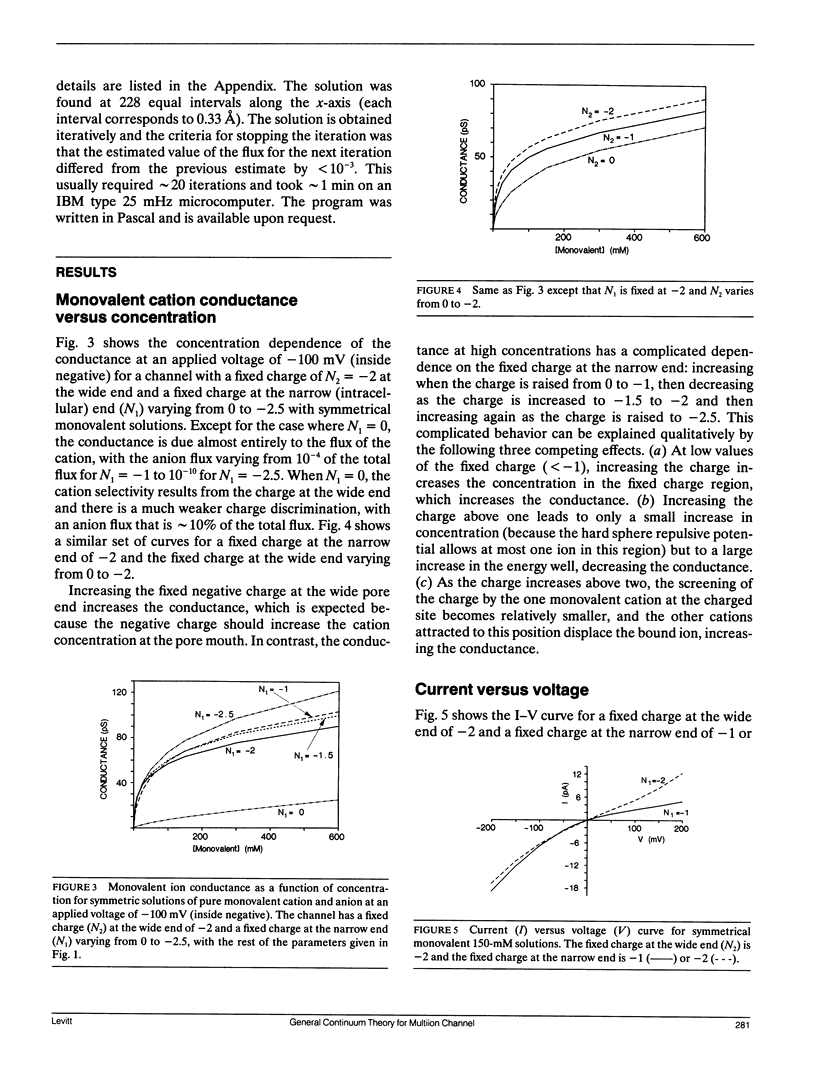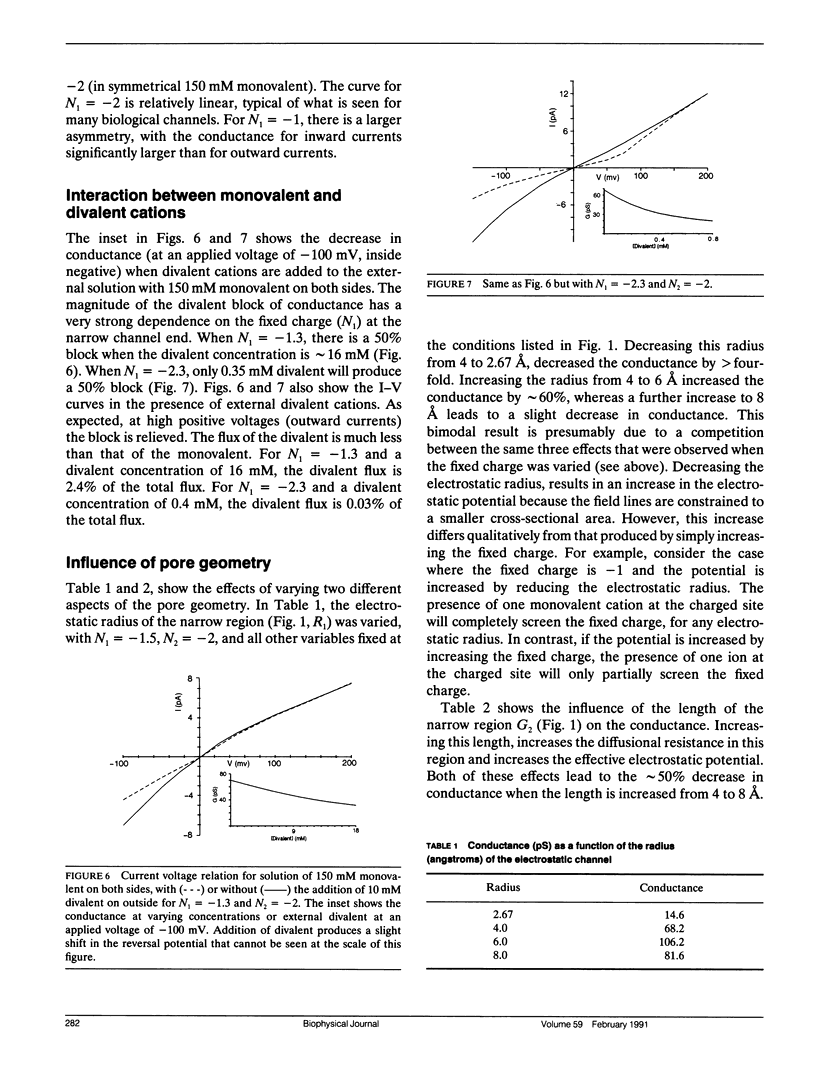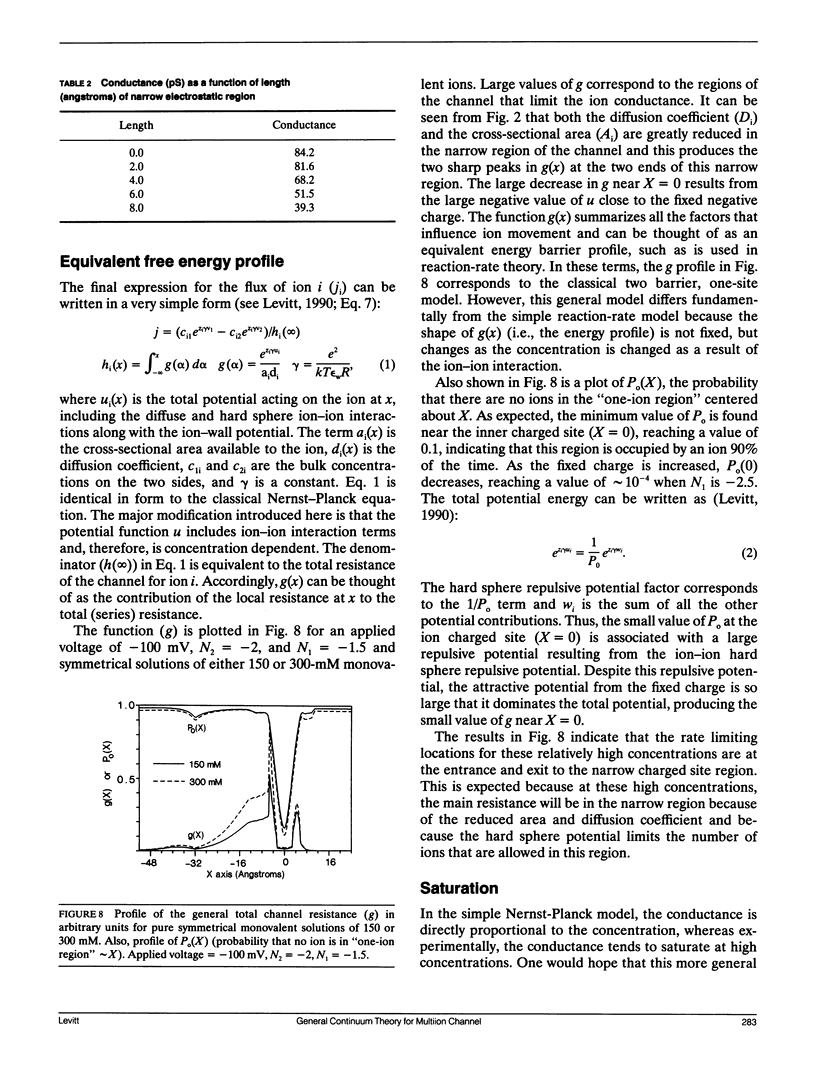Abstract
The general theory (Levitt, D. G. 1990. Biophys. J. 59:271-277) is applied to a model channel that resembles the acetylcholine receptor channel (ACH). The model incorporates the known features of the ACH geometry and fixed charge locations. The channel has a wide mouth facing the outer solution, tapering to a narrow region facing the interior of the cell. Rings of fixed negative charge are placed at the two surfaces where the bilayer begins, corresponding to the known charges at the ends of the M2 segment. It is assumed that the forces acting on the ion are electrostatic: ion-channel wall, ion-ion, Born image and applied voltage. Analytical expressions for these forces are derived that take account of the low dielectric lipid region. In addition, there is a local hard sphere repulsive force that prevents ions from piling up on each other in regions of the channel with a high fixed charge density. A classical continuum theory is used to obtain an expression for the diffusion coefficient in the channel. The model can mimic the major qualitative and, in many cases, quantitative experimental features of the ACH channel: current-voltage relation, conductance versus concentration and interaction between monovalent and divalent ions. The model calculations were also compared with the site directed mutagenesis experiments of Imoto, K., C. Busch, B. Sakmann, M. Mishina, T. Konno, J. Nakai, H. Bujo, Y. Mori, K. Fukuda, and S. Numa. (1988. Nature (Lond.). 335:645-648) in which the charge at the ends of the channel was systematically varied.
Full text
PDF










Selected References
These references are in PubMed. This may not be the complete list of references from this article.
- Ascher P., Nowak L. The role of divalent cations in the N-methyl-D-aspartate responses of mouse central neurones in culture. J Physiol. 1988 May;399:247–266. doi: 10.1113/jphysiol.1988.sp017078. [DOI] [PMC free article] [PubMed] [Google Scholar]
- Dani J. A., Eisenman G. Monovalent and divalent cation permeation in acetylcholine receptor channels. Ion transport related to structure. J Gen Physiol. 1987 Jun;89(6):959–983. doi: 10.1085/jgp.89.6.959. [DOI] [PMC free article] [PubMed] [Google Scholar]
- Dani J. A. Site-directed mutagenesis and single-channel currents define the ionic channel of the nicotinic acetylcholine receptor. Trends Neurosci. 1989 Apr;12(4):125–128. doi: 10.1016/0166-2236(89)90049-0. [DOI] [PubMed] [Google Scholar]
- Imoto K., Busch C., Sakmann B., Mishina M., Konno T., Nakai J., Bujo H., Mori Y., Fukuda K., Numa S. Rings of negatively charged amino acids determine the acetylcholine receptor channel conductance. Nature. 1988 Oct 13;335(6191):645–648. doi: 10.1038/335645a0. [DOI] [PubMed] [Google Scholar]
- Levitt D. G. Exact continuum solution for a channel that can be occupied by two ions. Biophys J. 1987 Sep;52(3):455–466. doi: 10.1016/S0006-3495(87)83234-4. [DOI] [PMC free article] [PubMed] [Google Scholar]
- Levitt D. G. General continuum analysis of transport through pores. I. Proof of Onsager's reciprocity postulate for uniform pore. Biophys J. 1975 Jun;15(6):533–551. doi: 10.1016/S0006-3495(75)85836-X. [DOI] [PMC free article] [PubMed] [Google Scholar]
- Levitt D. G. General continuum theory for multiion channel. I. Theory. Biophys J. 1991 Feb;59(2):271–277. doi: 10.1016/S0006-3495(91)82220-2. [DOI] [PMC free article] [PubMed] [Google Scholar]
- Levitt D. G. Strong electrolyte continuum theory solution for equilibrium profiles, diffusion limitation, and conductance in charged ion channels. Biophys J. 1985 Jul;48(1):19–31. doi: 10.1016/S0006-3495(85)83757-7. [DOI] [PMC free article] [PubMed] [Google Scholar]
- Patrick J., Boulter J., Goldman D., Gardner P., Heinemann S. Molecular biology of nicotinic acetylcholine receptors. Ann N Y Acad Sci. 1987;505:194–207. doi: 10.1111/j.1749-6632.1987.tb51292.x. [DOI] [PubMed] [Google Scholar]


